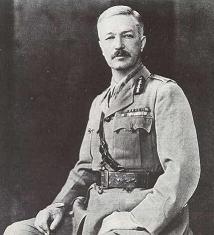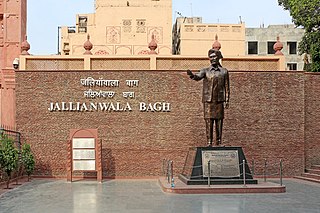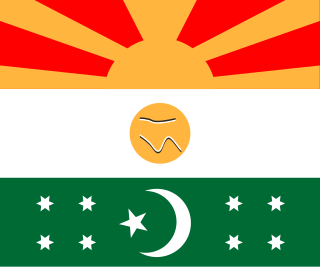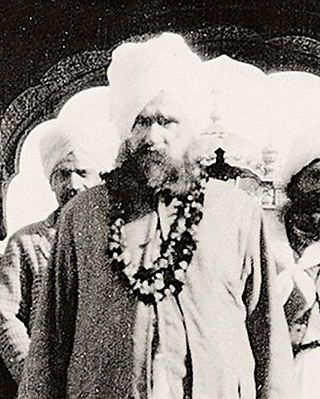
The Indian Independence Movement, was a series of historic events in South Asia with the ultimate aim of ending British colonial rule. It lasted until 1947, when the Indian Independence Act 1947 was passed.

Colonel Reginald Edward Harry Dyer, was an officer of the Bengal Army and later the newly constituted British Indian Army. His military career began in the regular British Army but he soon transferred to the presidency armies of India.

The Third Anglo-Afghan War began on 6 May 1919 when the Emirate of Afghanistan invaded British India and ended with an armistice on 8 August 1919. The Anglo-Afghan Treaty of 1919 resulted in the Afghans gaining control of foreign affairs from Britain and the British recognizing the Durand Line as the border between Afghanistan and British India.

The Anarchical and Revolutionary Crimes Act of 1919, popularly known as the Rowlatt Act, was a law, applied during the British India period. It was a legislative council act passed by the Imperial Legislative Council in Delhi on 18 March 1919, indefinitely extending the emergency measures of preventive indefinite detention, imprisonment without trial and judicial review enacted in the Defence of India Act 1915 during the First World War. It was enacted in the light of a perceived threat from revolutionary nationalists of re-engaging in similar conspiracies as had occurred during the war which the Government felt the lapse of the Defence of India Act would enable.
The Montagu–Chelmsford Reforms or more briefly known as the Mont–Ford Reforms, were introduced by the colonial government to introduce self-governing institutions gradually in British India. The reforms take their name from Edwin Montagu, the Secretary of State for India from 1917 to 1922, and Lord Chelmsford, the Viceroy of India between 1916 and 1921. The reforms were outlined in the Montagu-Chelmsford Report, prepared in 1918, and formed the basis of the Government of India Act 1919. These are related to constitutional reforms. Indian nationalists considered that the reforms did not go far enough, while British conservatives were critical of them. The important features of this act were that:

Jallianwala Bagh is a historic garden and memorial of national importance close to the Golden Temple complex in Amritsar, Punjab, India, preserved in the memory of those wounded and killed in the Jallianwala Bagh Massacre that took place on the site on the festival of Baisakhi Day, 13 April 1919. The 7-acre (28,000 m2) site houses a museum, gallery and several memorial structures. It is managed by the Jallianwala Bagh National Memorial Trust, and was renovated between 2019 and 2021.

Saifuddin Kitchlew was an Indian independence activist, barrister, politician and later a leader of the peace movement. A member of Indian National Congress, he first became Punjab Provincial Congress Committee head and later the General Secretary of the All India Congress Committee in 1924. He is most remembered for the protests in Punjab after the implementation of Rowlatt Act in March 1919, after which on 10 April, he and another leader Satyapal, were secretly sent to Dharamsala. A public protest rally against their arrest and that of Gandhi, on 13 April 1919 at Jallianwala Bagh, Amritsar, led to the infamous Jallianwala Bagh massacre. He was also a founding member of Jamia Millia Islamia. He was awarded the Stalin Peace Prize in 1952.

Sir Michael Francis O'Dwyer was an Irish colonial officer in the Indian Civil Service (ICS) and later the Lieutenant Governor of Punjab, British India, between 1913 and 1919.

The Provisional Government of India was a government-in-exile established in Kabul on December 1, 1915 by the Indian Independence Committee during World War I with support from the Central Powers. Its purpose was to enrol support from the Afghan Emir as well as Russia, China, and Japan for the Indian nationalist movement. Established at the conclusion of the Kabul Mission composed of members of the Berlin Committee, German and Turkish delegates, the provisional government was composed of Mahendra Pratap as President, Maulana Barkatullah as Prime Minister, Deobandi Maulavi Ubaidullah Sindhi as Home Minister, Deobandi Maulavi Bashir as Minister of War, and Champakraman Pillai as Foreign Minister. The provisional government found significant support from the internal administration of the Afghan government, although the Emir refused to declare open support, and ultimately, under British pressure it was forced to withdraw from Afghanistan in 1919.

The Jallianwala Bagh massacre, also known as the Amritsar massacre, took place on 13 April 1919. A large, peaceful crowd had gathered at the Jallianwala Bagh in Amritsar, Punjab, British India, during the annual Baishakhi fair to protest against the Rowlatt Act and the arrest of pro-independence activists Saifuddin Kitchlew and Satyapal. In response to the public gathering, the temporary brigadier general R. E. H. Dyer surrounded the people with his Gurkha and Sikh infantry regiments of the British Indian Army. The Jallianwala Bagh could only be exited on one side, as its other three sides were enclosed by buildings. After blocking the exit with his troops, Dyer ordered them to shoot at the crowd, continuing to fire even as the protestors tried to flee. The troops kept on firing until their ammunition was exhausted. Estimates of those killed vary from 379 to 1,500 or more people; over 1,200 others were injured, of whom 192 sustained serious injuries. Britain has never formally apologised for the massacre but expressed "deep regret" in 2019.
The Hindu–German Conspiracy(Note on the name) was a series of attempts between 1914 and 1917 by Indian nationalist groups to create a Pan-Indian rebellion against the British Empire during World War I. This rebellion was formulated between the Indian revolutionary underground and exiled or self-exiled nationalists in the United States. It also involved the Ghadar Party, and in Germany the Indian independence committee in the decade preceding the Great War. The conspiracy began at the start of the war, with extensive support from the German Foreign Office, the German consulate in San Francisco, and some support from Ottoman Turkey and the Irish republican movement. The most prominent plan attempted to foment unrest and trigger a Pan-Indian mutiny in the British Indian Army from Punjab to Singapore. It was to be executed in February 1915, and overthrow British rule in the Indian subcontinent. The February mutiny was ultimately thwarted when British intelligence infiltrated the Ghadarite movement and arrested key figures. Mutinies in smaller units and garrisons within India were also crushed.
The Ghadar Mutiny, also known as the Ghadar Conspiracy, was a plan to initiate a pan-India mutiny in the British Indian Army in February 1915 to end the British Raj in India. The plot originated at the onset of World War I, between the Ghadar Party in the United States, the Berlin Committee in Germany, the Indian revolutionary underground in British India and the German Foreign Office through the consulate in San Francisco. The incident derives its name from the North American Ghadar Party, whose members of the Punjabi community in Canada and the United States were among the most prominent participants in the plan. It was the most prominent amongst a number of plans of the much larger Hindu–German Mutiny, formulated between 1914 and 1917 to initiate a Pan-Indian rebellion against the British Raj during World War I. The mutiny was planned to start in the key state of Punjab, followed by mutinies in Bengal and rest of India. Indian units as far as Singapore were planned to participate in the rebellion. The plans were thwarted through a coordinated intelligence and police response. British intelligence infiltrated the Ghadarite movement in Canada and in India, and last-minute intelligence from a spy helped crush the planned uprising in Punjab before it started. Key figures were arrested, and mutinies in smaller units and garrisons within India were also crushed.

The Niedermayer–Hentig Expedition, also known as the Kabul Mission, was a diplomatic mission to Afghanistan sent by the Central Powers in 1915–1916. The purpose was to encourage Afghanistan to declare full independence from the British Empire, enter World War I on the side of the Central Powers, and attack British India. The expedition was part of the Hindu–German Conspiracy, a series of Indo-German efforts to provoke a nationalist revolution in India. Nominally headed by the exiled Indian prince Raja Mahendra Pratap, the expedition was a joint operation of Germany and Turkey and was led by the German Army officers Oskar Niedermayer and Werner Otto von Hentig. Other participants included members of an Indian nationalist organisation called the Berlin Committee, including Maulavi Barkatullah and Chempakaraman Pillai, while the Turks were represented by Kazim Bey, a close confidante of Enver Pasha.

The Defence of India Act 1915, also referred to as the Defence of India Regulations Act, was an emergency criminal law enacted by the Governor-General of India in 1915 with the intention of curtailing the nationalist and revolutionary activities during and in the aftermath of the First World War. It was similar to the British Defence of the Realm Acts, and granted the Executive very wide powers of preventive detention, internment without trial, restriction of writing, speech, and of movement. However, unlike the English law which was limited to persons of hostile associations or origin, the Defence of India act could be applied to any subject of the King, and was used to an overwhelming extent against Indians. The passage of the act was supported unanimously by the non-official Indian members in the Viceroy's legislative council, and was seen as necessary to protect against British India from subversive nationalist violence. The act was first applied during the First Lahore Conspiracy trial in the aftermath of the failed Ghadar Conspiracy of 1915, and was instrumental in crushing the Ghadr movement in Punjab and the Anushilan Samiti in Bengal. However its widespread and indiscriminate use in stifling genuine political discourse made it deeply unpopular, and became increasingly reviled within India. The extension of the law in the form of the Rowlatt Act after the end of World War I was opposed unanimously by the non-official Indian members of the Viceroy's council. It became a flashpoint of political discontent and nationalist agitation, culminating in the Rowlatt Satyagraha. The act was re-enacted during World War II as Defence of India act 1939. Independent India retained the law in a number of amended forms, which have seen use in proclaimed states of national emergency including Sino-Indian War, Bangladesh crisis, The Emergency of 1975 and subsequently the Punjab insurgency.
The Hindu–German Conspiracy failed to engage popular support within India. However, it had a significant impact on Britain's policies both in the empire, as well as on her international relations. The outlines and plans for the nascent ideas of the conspiracy were noted and began to be tracked by the British intelligence as early as 1911. Alarmed at the agile organisation, which repeatedly reformed at different parts of the country despite being subdued in others, the chief of Indian Intelligence Sir Charles Cleveland was forced to warn that the idea and attempt at pan-Indian revolutions were spreading through India "like some hidden fire". A massive, concerted and coordinated effort was required to subdue the movement. Attempts were made in 1914 to prevent the naturalisation of Tarak Nath Das as an American citizen, while successful pressure was applied to have Har Dayal interned. The conspiracy had been detected early by British intelligence, and had been the subject of strong British pressure from 1914.
British counter-intelligence against the Indian revolutionary movement during World War I began from its initial roots in the late-19th century and ultimately came to span in extent from Asia through Europe to the West Coast of the United States and Canada. It was effective in thwarting a number of attempts for insurrection in British India during World War I and ultimately in controlling the Indian revolutionary movement both at home and abroad.

Sir Sidney Arthur Taylor Rowlatt, KCSI, PC was a British barrister and judge, remembered in part for his presidency of the sedition committee that bore his name, created in 1918 by the imperial government to subjugate and control the independence movement in British India, especially Bengal and the Punjab. The committee gave rise to the Rowlatt Act, an extension of the Defence of India Act 1915.

Arur Singh Shergill was Sikh magistrate and civil judge who served as the manager of Darbar Sahib and the 10th Jathedar of the Akal Takht, as a sarbarah appointed by the British Raj from 1907 to 1920.
Nick Lloyd FRHS, is Professor of Modern Warfare at King's College London. He has written several books on the First World War.
Hans Raj was an Indian youth, in Amritsar, British India, who in June 1919 became an approver for the British government when he gave evidence for the Crown at the Amritsar Conspiracy Case Trial in which he identified his fellow Indian revolutionaries, buying his own freedom in return.














